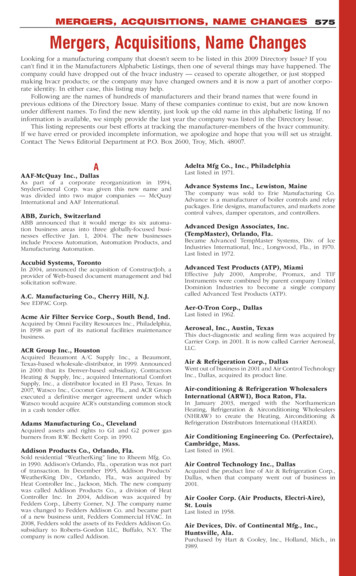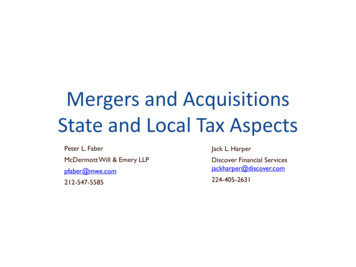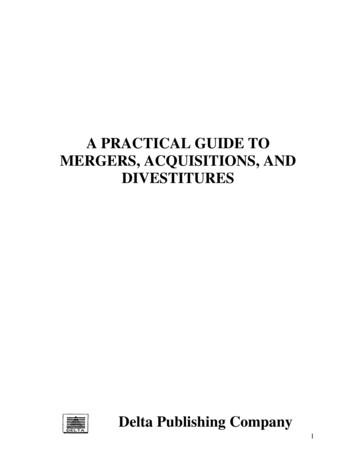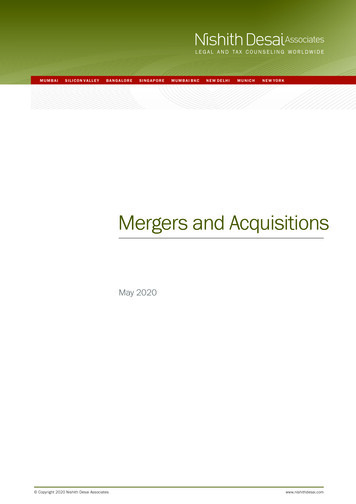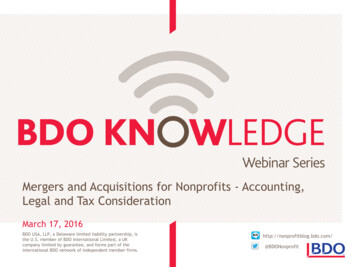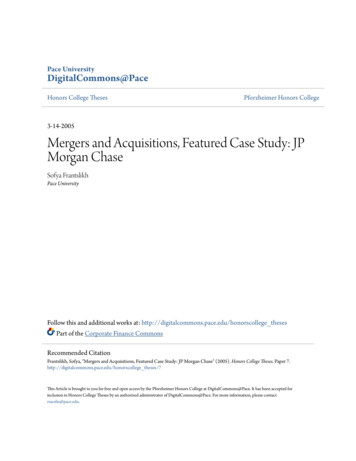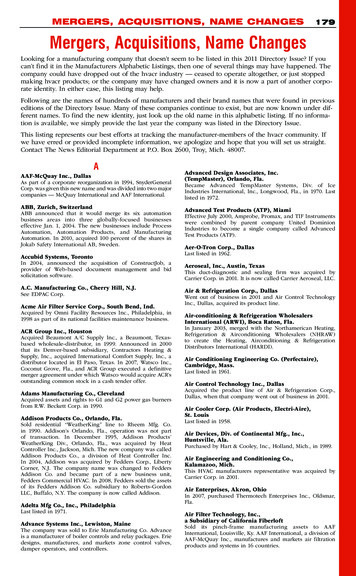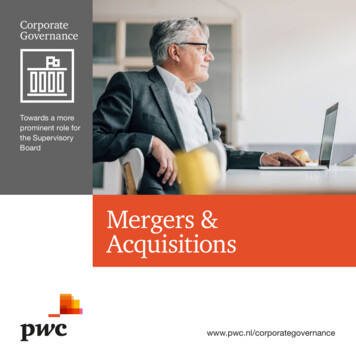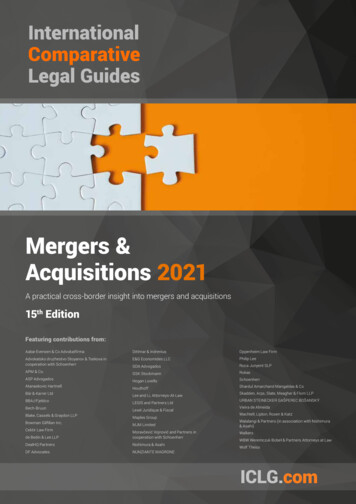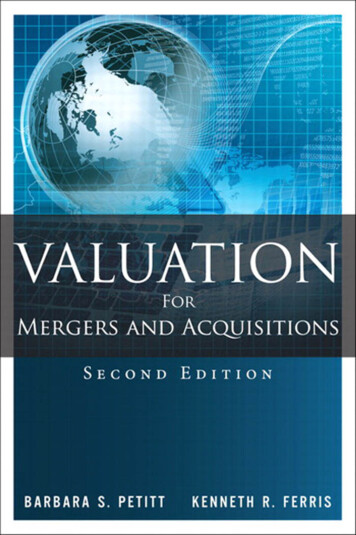
Transcription
Valuation for Mergersand AcquisitionsSecond EditionBarbara S. Petitt, CFAKenneth R. Ferris
Vice President, Publisher: Tim MooreAssociate Publisher and Director of Marketing: Amy NeidlingerAcquisitions Editor: Russ HallEditorial Assistant: Pamela BolandOperations Specialist: Jodi KemperMarketing Manager: Lisa LoftusCover Designer: Chuti PrasertsithManaging Editor: Kristy HartSenior Project Editor: Lori LyonsCopy Editor: Krista Hansing Editorial ServicesProofreader: Kathy RuizIndexer: Erika MillenCompositor: Nonie RatcliffManufacturing Buyer: Dan Uhrig 2013 by Pearson Education, Inc.Publishing as FT PressUpper Saddle River, New Jersey 07458This book is sold with the understanding that neither the authors nor the publisher is engagedin rendering legal, accounting, or other professional services or advice by publishing this book.Each individual situation is unique. Thus, if legal or financial advice or other expert assistanceis required in a specific situation, the services of a competent professional should be soughtto ensure that the situation has been evaluated carefully and appropriately. The authors andthe publisher disclaim any liability, loss, or risk resulting directly or indirectly, from the use orapplication of any of the contents of this book.FT Press offers excellent discounts on this book when ordered in quantity for bulk purchasesor special sales. For more information, please contact U.S. Corporate and Government Sales,1-800-382-3419, corpsales@pearsontechgroup.com. For sales outside the U.S., please contactInternational Sales at international@pearsoned.com.Company and product names mentioned herein are the trademarks or registered trademarksof their respective owners.All rights reserved. No part of this book may be reproduced, in any form or by any means,without permission in writing from the publisher.Printed in the United States of AmericaFirst Printing June 2013ISBN-10: 0-13-337267-7ISBN-13: 978-0-13-337267-0Pearson Education LTD.Pearson Education Australia PTY, Limited.Pearson Education Singapore, Pte. Ltd.Pearson Education Asia, Ltd.Pearson Education Canada, Ltd.Pearson Educación de Mexico, S.A. de C.V.Pearson Education—JapanPearson Education Malaysia, Pte. Ltd.Library of Congress Control Number: 2013935801
ContentsPreface . . . . . . . . . . . . . . . . . . . . . . . . . . . . . . . . . . . . . . . viiChapter 1Valuation: An Overview . . . . . . . . . . . . . . . . . . . . . . . . . . . 1Market View . . . . . . . . . . . . . . . . . . . . . . . . . . . . . . . . . . . . . 11 Why Companies Merge or Acquire: A HistoricalPerspective . . . . . . . . . . . . . . . . . . . . . . . . . . . . . . . . . . . . . . 31.1 Mergers and Acquisitions Waves . . . . . . . . . . . . . . . 31.2 Motivations for Mergers and Acquisitions. . . . . . . . 62 Do Mergers and Acquisitions Create ShareholderValue? . . . . . . . . . . . . . . . . . . . . . . . . . . . . . . . . . . . . . . . . . . 83 Merger and Acquisition Premiums . . . . . . . . . . . . . . . . . 94 Valuation Process . . . . . . . . . . . . . . . . . . . . . . . . . . . . . . 105 Valuation Methods: An Overview . . . . . . . . . . . . . . . . . 125.1 Relative Valuation Methods . . . . . . . . . . . . . . . . . . 145.2 Direct Valuation Methods . . . . . . . . . . . . . . . . . . . 175.3 The Use of Valuation Methods. . . . . . . . . . . . . . . . 19Summary . . . . . . . . . . . . . . . . . . . . . . . . . . . . . . . . . . . . . . . 20Endnotes . . . . . . . . . . . . . . . . . . . . . . . . . . . . . . . . . . . . . . . 20Chapter 2Financial Review and Pro Forma Analysis . . . . . . . . . . . 23Market View . . . . . . . . . . . . . . . . . . . . . . . . . . . . . . . . . . . .1 Financial Review. . . . . . . . . . . . . . . . . . . . . . . . . . . . . . .1.1 Ratio Analysis . . . . . . . . . . . . . . . . . . . . . . . . . . . . .1.2 Decomposition Analysis . . . . . . . . . . . . . . . . . . . . .1.3 Cash Flow Analysis . . . . . . . . . . . . . . . . . . . . . . . . . . .2 Pro Forma Analysis. . . . . . . . . . . . . . . . . . . . . . . . . . . . .2.1 Pro Forma Financial Statements . . . . . . . . . . . . . .2.2 Sensitivity, Scenario, and Monte CarloSimulation Analyses . . . . . . . . . . . . . . . . . . . . . . . . . . . .Summary . . . . . . . . . . . . . . . . . . . . . . . . . . . . . . . . . . . . . . .Endnotes . . . . . . . . . . . . . . . . . . . . . . . . . . . . . . . . . . . . . . .Appendix 2A: Mattel’s Financial Statements. . . . . . . . . . .Appendix 2B: Preparation of a Cash Flow Statement. . . .Cash Flow Fundamentals . . . . . . . . . . . . . . . . . . . . . . .23252632424949596061666969
ivVALUATION FOR MERGERS AND ACQUISITIONSSummary . . . . . . . . . . . . . . . . . . . . . . . . . . . . . . . . . . . . . . . 81Appendix 2C: Account Forecasting Alternatives. . . . . . . . 82Chapter 3Traditional Valuation Methods . . . . . . . . . . . . . . . . . . . . 85Market View . . . . . . . . . . . . . . . . . . . . . . . . . . . . . . . . . . . . 851 Earnings Multiples . . . . . . . . . . . . . . . . . . . . . . . . . . . . . 872 Discounted Cash Flow Models . . . . . . . . . . . . . . . . . . . 922.1 Operational Dilemmas . . . . . . . . . . . . . . . . . . . . . . 922.2 Estimating the Entity Value andEquity Value. . . . . . . . . . . . . . . . . . . . . . . . . . . . . . . . . 1042.3 A Survey of Best Practices . . . . . . . . . . . . . . . . . . 1082.4 Cross-Border Considerations . . . . . . . . . . . . . . . . 1092.5 Illustration . . . . . . . . . . . . . . . . . . . . . . . . . . . . . . . 111Summary . . . . . . . . . . . . . . . . . . . . . . . . . . . . . . . . . . . . . . 118Endnotes . . . . . . . . . . . . . . . . . . . . . . . . . . . . . . . . . . . . . . 119Appendix 3: Some Frequently Asked Questions andAnswers About the Free Cash Flow to the FirmModel and Earnings Multiples. . . . . . . . . . . . . . . . . . . . . 124Chapter 4Alternative Valuation Methods . . . . . . . . . . . . . . . . . . . 133Market View . . . . . . . . . . . . . . . . . . . . . . . . . . . . . . . . . . .1 Relative Valuation Methods . . . . . . . . . . . . . . . . . . . . .1.1 Price Multiples . . . . . . . . . . . . . . . . . . . . . . . . . . .1.2 Enterprise Value Multiples . . . . . . . . . . . . . . . . .2 Direct Valuation Methods . . . . . . . . . . . . . . . . . . . . . .2.1 Discounted Cash Flow Models . . . . . . . . . . . . . .2.2 Economic Income Models . . . . . . . . . . . . . . . . . .2.3 Real Option Analysis. . . . . . . . . . . . . . . . . . . . . . .Summary . . . . . . . . . . . . . . . . . . . . . . . . . . . . . . . . . . . . . .Endnotes . . . . . . . . . . . . . . . . . . . . . . . . . . . . . . . . . . . . . .Appendix 4: How to Use the Black-Scholes Modelto Value a Red Option . . . . . . . . . . . . . . . . . . . . . . . . . . .Black-Scholes Model . . . . . . . . . . . . . . . . . . . . . . . . . . . .Luehrman’s NPVq/Cumulative Volatility Approach . . . .Chapter 5133136136141144144158165170171176177178Accounting Dilemmas in Valuation Analysis . . . . . . . . 181Market View . . . . . . . . . . . . . . . . . . . . . . . . . . . . . . . . . . . 1811 Assessing Economic Reality . . . . . . . . . . . . . . . . . . . . . 183
CONTENTS2 Income Statement Transformations: ForecastingPermanent Earnings and Free Cash Flows . . . . . . . . . . .2.1 Recurring and Nonrecurring Events . . . . . . . . . .2.2 Revenue Recognition Policy. . . . . . . . . . . . . . . . .2.3 Inventory Costing Policy . . . . . . . . . . . . . . . . . . .2.4 Depreciation Policy . . . . . . . . . . . . . . . . . . . . . . .3 Balance Sheet Transformations: Forecastingthe Equity Value of a Company . . . . . . . . . . . . . . . . . . . .3.1 Asset Capitalization Policy . . . . . . . . . . . . . . . . . .3.2 Asset Revaluation Policy. . . . . . . . . . . . . . . . . . . .3.3 Off-Balance-Sheet Debt. . . . . . . . . . . . . . . . . . . .4 Cash Flow Statement Transformations: ForecastingCFFO and Free Cash Flow . . . . . . . . . . . . . . . . . . . . . . .Summary . . . . . . . . . . . . . . . . . . . . . . . . . . . . . . . . . . . . . .Endnotes . . . . . . . . . . . . . . . . . . . . . . . . . . . . . . . . . . . . . .Chapter 6185185186190193195196199200205206208Financial Reporting and Tax Considerationsfor Mergers and Acquisitions . . . . . . . . . . . . . . . . . . . . 211Market View . . . . . . . . . . . . . . . . . . . . . . . . . . . . . . . . . . .1 Financial Reporting: To Combine or Notto Combine? . . . . . . . . . . . . . . . . . . . . . . . . . . . . . . . . . . .2 Consolidated Financial Reporting: PurchaseAccounting . . . . . . . . . . . . . . . . . . . . . . . . . . . . . . . . . . . .3 Noncontrolling Interest . . . . . . . . . . . . . . . . . . . . . . . .4 Accounting for Goodwill. . . . . . . . . . . . . . . . . . . . . . . .5 Tax Considerations of Mergersand Acquisitions . . . . . . . . . . . . . . . . . . . . . . . . . . . . . . . .6 Tax Considerations of Goodwill . . . . . . . . . . . . . . . . . .Summary . . . . . . . . . . . . . . . . . . . . . . . . . . . . . . . . . . . . . .Endnotes . . . . . . . . . . . . . . . . . . . . . . . . . . . . . . . . . . . . . .Chapter 7v211213214218220222224225225Some Final Thoughts. . . . . . . . . . . . . . . . . . . . . . . . . . . 229Market View . . . . . . . . . . . . . . . . . . . . . . . . . . . . . . . . . . .1 Valuation: A Debriefing . . . . . . . . . . . . . . . . . . . . . . . .2 Some Caveats to Consider . . . . . . . . . . . . . . . . . . . . . .3 Closure . . . . . . . . . . . . . . . . . . . . . . . . . . . . . . . . . . . . .Endnote. . . . . . . . . . . . . . . . . . . . . . . . . . . . . . . . . . . . . . .229230231233233Bibliography . . . . . . . . . . . . . . . . . . . . . . . . . . . . . . . . . . 235Index . . . . . . . . . . . . . . . . . . . . . . . . . . . . . . . . . . . . . . . 239
About the AuthorsBarbara S. Petitt, PhD, CFA, is Director, Curriculum Projects, EMEA at CFA Institute. She has an in-depth knowledge ofequity valuation, mergers, acquisitions, and corporate restructurings.She has held academic positions at Thunderbird, School of GlobalManagement in the U.S., Bournemouth University in the U.K., andSKEMA Business School in France, and consulted with corporateclients throughout Europe and North America. Petitt resides inPoole, U.K.Kenneth R. Ferris, a valuation and acquisition consultant tosmall and mid-cap companies in Central America, served on the faculty at Northwestern’s Kellogg School of Management; SMU’s CoxSchool of Business; Thunderbird School of Global Management;Drucker School of Business at Claremont Graduate School, and Arizona State’s W.P. Carey School of Business. He was a director forthree NYSE-listed firms. Ferris resides in Placencia, Belize.
PrefaceValuation is the essence of finance. It asks the question, “Whatis the ‘fair’ price to pay for an asset that has a set of uncertain futurecash flows?” This book presents a practitioner-oriented view of thefundamentals of valuation in the context of mergers and acquisitions.Valuation is considered to be an art, not a science. Thus, the readerwill find that there are many “rules of thumb” and few inviolable principles to guide them.The metrics used for valuing companies are not well-defined,varying according to the objectives of the valuation, the characteristicsof the company and its industry, and the preferences and expertiseof the individual performing the valuation. Consequently, corporateexecutives and valuation analysts face many choices and dilemmas asthey try to assess a company’s value. Throughout this book, we discussa range of valuation methods, including multiples, discounted cashflow models, economic income models, and option pricing models.We offer practical solutions for helping the reader make informedchoices and for dealing with common dilemmas. The valuation methods discussed are principally for use in non-financial companies; thetopic of valuing financial companies is beyond the scope of this book.To use this book effectively, the reader will need an understanding of the fundamentals of accounting and finance. Furthermore, abackground in financial modeling with Excel is also beneficial.Barbara S. Petitt and Kenneth R. FerrisMay 2013
This page intentionally left blank
1Valuation: An OverviewMarket ViewWhat do Daimler-Benz, Hewlett-Packard (HP), Microsoft,Quaker Oats, and Sprint have in common? They are all multinationalcompanies with established brands and products. But they have something else in common: They have all made bad acquisitions! In 1994,Quaker Oats acquired Snapple for 1.7 billion; it sold Snapple to aninvestment company for only 300 million two years later. Daimlerpurchased Chrysler for 36 billion in 1998; it got only 7.4 billionwhen it sold 80 percent of Chrysler to a private equity firm nine yearslater. HP, Sprint, and Microsoft also failed to make their acquisitionsof Electronic Data System, Nextel Communications, and aQuantivework. These companies had to write off a significant portion of theprice they paid for their targets—58, 86, and 98 percent, respectively.Unfortunately, these examples are not exceptional. Bad acquisitionshappen in all countries, in all industries, and during both bull andbear markets.Acquisitions fail for different reasons, but one recurrent themeis that acquirers overpay for the target. They overestimate either thetarget’s value, the expected synergies associated with the acquisition,or both. When the benefits of the acquisition fail to materialize, anacquirer has to write off part, and sometimes all, of the purchaseprice. Some companies, such as Quaker Oats and Daimler, might beable to recoup at least a small portion of the loss; others are not sofortunate and end up shuttering the business they acquired.1
2VALUATION FOR MERGERS AND ACQUISITIONSDo not conclude, however, that all mergers and acquisitions(M&As) are bound to fail. Some of the strongest companies as of thiswriting are the result of large M&As: The combinations of Exxon andMobil in 1998, Vodafone and Mannesmann in 1999, Pfizer and Warner Lambert in 1999, and JPMorgan Chase and Bank One in 2004created leaders in the oil and gas, telecommunication, pharmaceutical, and banking industries, respectively. Acquisitions that are wellplanned and well executed offer companies the opportunity to growsuccessfully.One of the critical aspects of the planning stage is the valuation ofthe target and the expected synergies between the acquirer and thetarget. As this book illustrates, overestimating the target’s value and/or the expected synergies associated with the acquisition is a sure pathto overpaying and reducing the likelihood of making the acquisitiona success.***Probably no question in the financial community is asked moreoften than “What is this investment worth?” Whether the investmentis a share of stock, a bond, or a company, assessing the value of aninvestment is often the ultimate objective of the corporate executiveor analyst.The fundamental tenet of valuation is well established in corporate finance: The value of an asset (or bundle of assets) today is thepresent value of the future cash flows that the asset is expected to provide its owners during its economic life. Thus, a significant aspect ofvaluation involves modeling the future cash flows associated with aninvestment and then deciding how to value those cash flows. Becausefinancial modeling can be time consuming and often imprecise, analysts frequently turn to shortcut techniques that (they hope) yield similar results. Alternative valuation methods have also emerged becausenot all investments have sufficiently predictable cash flows to permit effective financial modeling. The chapters that follow consider avariety of valuation methods: discounted cash flow models, price andenterprise value multiples, economic value analysis, and real optionanalysis. We consider each of those valuation methods in the context
CHAPTER 1 VALUATION: AN OVERVIEW3of corporate valuation for M&A purposes, although they can be usedfor a variety of objectives.This chapter addresses the following key questions: What are the principal reasons companies merge with oracquire one another? Do M&As create shareholder value? Why do acquirers pay a premium to take control of a target? What are the typical steps to follow when valuing a company? What are the most frequently used valuation methods forassessing a company’s value?1 Why Companies Merge or Acquire:A Historical PerspectiveCompanies grow in two main ways: either organically or by merging with or acquiring other companies. Although the number and volume of M&As broke records in the first decade of the 21st century,these transactions are not a recent phenomenon. We begin our journey by identifying the periods that were characterized by a high levelof M&A activity and then summarize the major reasons companiesmake acquisitions.1.1 Mergers and Acquisitions WavesM&As come in “waves.” Martynova and Renneboog (2008)reviewed a century of transactions and identified six major waves ofM&As: 1890–1903, 1910–1929, 1950–1973, 1981–1989, 1993–2001,and 2003–2007. Their research shows that the end of a wave typicallycoincides with a crisis or a recession—for example, the most recentwave ended with the subprime debt crisis in 2007. What triggers thestart of a wave varies across time, but three factors have clearly drivenM&A activity since the end of the 19th century: industrial and technological shocks, regulatory changes, and credit availability.
4VALUATION FOR MERGERS AND ACQUISITIONSThe 1890s and early 1900s witnessed what is considered the firstwave of M&As. Companies in the United States tried to build monopolies in their respective industries by forming trusts—in essence, anextreme form of horizontal integration. Examples include the creation of Standard Oil Company of New Jersey in 1899, United StatesSteel Corporation in 1901, and International Harvester Corporationin 1902. After the government enacted laws prohibiting anticompetitive behavior, acquisition-oriented companies turned their attentionto vertical integration as a means of growth. Vertical integration isperhaps best illustrated by the oil and gas industry; companies thatbegan as pure oil exploration businesses eventually moved into refining, transportation, and, ultimately, retailing of oil and gas products.Most of the M&As that took place during the second wave inthe 1920s involved small U.S. companies that were left outside themonopolies created during the previous wave. Those companiesmerged with or acquired one another to gain economies of scale andto be able to compete with the dominant player in their industry. The1929 crisis and the depression that followed put an end to this secondwave of M&As. Because of World War II, M&A activity remained lowuntil the 1950s.The 1950s, 1960s, and early 1970s witnessed a third wave of M&As,during which companies tried to diversify their revenue streams and,in doing so, reduce their perceived riskiness. This trend led to the creation of conglomerates and holding companies composed of manyunrelated businesses. General Electric Company is a typical exampleof this trend. However, today’s capital markets no longer place a premium on highly diversified companies. In fact, the share prices ofmost highly diversified companies are subject to a conglomeratediscount because equity markets struggle to see the benefits of thesecomplex enterprises.1 In essence, equity markets now prefer “pureplays”—that is, companies that operate in a single industry—to highlydiversified companies, in large part because understanding and valuing pure plays is easier than conglomerates. This third wave of M&Aspeaked in 1968 and collapsed with the oil crisis in 1973.The late 1970s and early 1980s were characterized by relativelyhigh inflation rates and, consequently, high borrowing costs. To remainprofitable, many companies sought ways to reduce both operating
CHAPTER 1 VALUATION: AN OVERVIEW5and financing costs. Reaching a critical size was often viewed as theway to survive the industry “shake-outs” that inevitably characterizesuch economic periods, giving rise to the fourth wave of M&As. Manycompanies merged with or acquire one another to take advantageof the economies of scale associated with larger-volume producers.Moreover, some companies saw M&As as a means to reduce theirriskiness and lower their financing costs, which reached as high as 25to 30 percent in some instances in the late 1970s and early 1980s.The 1980s were also marked by deregulation and the creation anddevelopment of new instruments and markets. One such example isthe “junk” bond market, or the market for bonds issued by companieswith poor credit quality.2 The availability of credit to finance highlyrisky companies and transactions fuelled an increase in leveragedbuyouts (LBOs) and leveraged recapitalizations.3 Some companiesthat had bought unrelated businesses during the previous wave tookadvantage of the booming M&A market to sell their poorly performing divisions and refocus on their core business. The stock marketcrash of 1987 and the collapse of several highly leveraged companiesput an end to this fourth wave of M&As.The 1990s saw new justifications for acquisitions emerge, pavingthe way for a fifth wave of M&As. Some companies made acquisitions to gain access to knowledge-based assets, particularly in the late1990s, when the “first mover” advantage became highly prized. The1990s also witnessed an increase in the number and volume of crossborder acquisitions. With the evolution of the global economy, manycompanies saw M&As as the quickest and least expensive means ofacquiring a presence in a foreign country and preserving their place inthe global economy. This latter trend was largely driven by the formation of multination trade zones such as the European Union (E.U.),Mercosur, and the North Atlantic Free Trade Agreement (NAFTA).In addition, some companies viewed M&As as an opportunity toconsolidate industries characterized by excess market participantsand, hence, low profitability. These “consolidators” recognized thatnot every participant could survive such economic conditions and fostered a mentality of “Acquire or be acquired.” Examples of industriesaffected by this global trend include the oil and gas industry (consider the mergers of British Petroleum [BP] and Amoco, and of Exxon
6VALUATION FOR MERGERS AND ACQUISITIONSand Mobil), the pharmaceutical industry (for example, the creationsof Pharmacia, the result of the merger of Pharmacia & Upjohn withMonsanto, and of GlaxoSmithKline, the result of the merger of SmithKline Beecham and Glaxo Wellcome), and the automobile industry(think of the merger of Daimler and Chrysler, and the acquisitionof Volvo by Ford). The burst of the dotcom bubble in 2000 and therecession that followed marked the end of this fifth wave of M&As.M&A activity soon recovered, with a sixth wave starting in 2003.This wave saw the continuation of the two trends initiated in the1990s: cross-border acquisitions and industry consolidations. But itwas also reminiscent of the 1980s, in that leveraged transactions madea comeback. The low-interest environment coupled with the seemingly endless credit availability fuelled an increase in LBOs, manysponsored by private equity firms. Investors went in search of diversification benefits and higher yields. As they poured money into newasset classes such as private equity, large amounts of funds becameavailable to take companies private and purchase divisions for sale.This sixth wave of M&As came to an abrupt end following the subprime debt crisis of 2007.As of this writing, M&A activity is picking up, and some marketparticipants are suggesting that a new wave of M&As could be underway. However, it is too early to tell.1.2 Motivations for Mergers and AcquisitionsCompanies make acquisitions for a long list of reasons. Some ofthese reasons are good, in that the motivation for the transaction is tomaximize shareholder value. Unfortunately, other reasons are bad, orat least questionable.Theoretically, companies should pursue an acquisition only if itcreates value—that is, if the value of the acquirer and the target isgreater if they operate as a single entity than as separate ones. Putanother way, a merger or acquisition is justified if synergies are associated with the transaction. Synergies can take three forms: operating,financial, or managerial.Operating synergies arise from the combination of the acquirerand target’s operations. A first type of operating synergies is revenue
CHAPTER 1 VALUATION: AN OVERVIEW7enhancement. It includes gaining pricing power in a particular market or being able to increase sales volume by accessing new markets—for example, by leveraging one company’s sales force or distributionnetwork, or by selling one company’s products to the other company’scustomers. A second type of operating synergies is cost reduction. Asmentioned earlier, many companies view M&As as a way to reach acritical size and, consequently, be able to benefit from economies ofscale with lower production costs. An acquisition might also generatecost savings in advertising, marketing, or research and development.Revenue enhancement and cost reduction are more likely in cases ofhorizontal integration and can also play a role in vertical integration.Financial synergies come from lower financing costs. Big companies usually have access to a wider and cheaper pool of funds thansmall companies. One rationale for the third wave of M&As was thatdiversifying into unrelated businesses enabled companies to reducerisk and, therefore, increase their debt capacity and lower their beforetax cost of financing. The risk reduction benefit is compounded by thebeneficial tax treatment of debt relative to equity. Thus, the moredebt a company has in its capital structure, the lower its cost of financing, net of taxes.4 History has shown, however, that companies tendto overestimate the risk reduction and tax benefits associated withM&As. Although financial synergies are a source of value, particularlyin the case of leveraged transactions such as LBOs, they should not bethe only motivation for a merger or acquisition.Managerial synergies arise when a high-performing management team replaces a poor-performing one. One advantage ofacquisitions is that they give the acquirer the opportunity to removeincompetent managers, which could improve the target’s performance.Unfortunately, not all M&As are motivated by the goal of creating shareholder value. Research has shown that some managers lookafter their own self-interest instead of shareholders’.5 They might useM&As to build empires and diversify their human capital, even if littleor no value is associated with the merger or the acquisition.6 Managers also sometimes suffer from hubris; they are overconfident in theirability to negotiate a good deal for their shareholders and then runthe combined entity.7 Thus, they tend to overpay for their acquisitions. Last, some managers go through an acquisition spree to deliver
8VALUATION FOR MERGERS AND ACQUISITIONSgrowth and earnings targets, even if the acquisitions are not strategically sound or have a negative effect on the company’s profitabilityand ability to create shareholder value.2 Do Mergers and Acquisitions CreateShareholder Value?Although evidence clearly indicates that the shareholders of a target profit from a merger or acquisition, the same cannot be said forthe shareholders of the acquirer. An abundance of studies show thatthe share price of almost all targets increases around the announcement of a merger or an acquisition. However, the share price ofacquirers rarely follows the same trend; the average share price performance of acquirers around the announcement of a merger or anacquisition is slightly negative, and acquirers commonly experience asignificant decrease in share price after announcing their intention tomerge with or acquire another company. Kengelbach and Roos, fromthe Boston Consulting Group (BCG) (2011), studied approximately26,000 transactions completed between 1988 and 2010. They showedthat the average share price performance over a seven-day windowcentered on the announcement date was 15.5 percent for the targetbut –1.0 percent for the acquirer. The study revealed that acquirersperform better if they purchase a foreign target instead of a domesticone, if they pay in cash rather than in securities or a mix of cash andsecurities, if they make only one acquisition, and if the acquisitiontakes place during a downturn rather than an upturn. A follow-upstudy by Kengelbach, Kemmer, and Roos (2012) also indicated thatsome sectors fare better than others. For instance, the share priceperformance for an average acquirer was 1.9 percent in the manufacturing sector but –2.2 percent in the telecommunication sector.8This evidence suggests, among other things, that equity marketsare skeptical about the ability of acquirers to create shareholder value.Whether offer prices are seen as excessive, the proposed synergies arethought unlikely to materialize, or current management is perceivedas incapable of successfully merging two different cultures, equitymarkets doubt the value associated with most transactions. Sadly,
CHAPTER 1 VALUATION: AN OVERVIEW9equity markets are correct: Few transactions achieve their anticipatedgains. KPMG (2011) analyzed a large sample of M&As completedbetween January 2007 and July 2009 and showed that, in 44 percentof the transactions, the acquirer achieved either none or very littleof the anticipated synergies. Moreover, Kengelbach, et al. (2012),observed that, in 2011, divestitures made up 45 percent of the number of M&As. As mentioned in the vignette at the beginning of thischapter, it is not unusual for companies to end up selling their poorlyperforming acquisitions.To help understand
equity valuation, mergers, acquisitions, and corporate restructurings. She has held academic positions at Thunderbird, School of Global Management in the U.S., Bournemouth University in the U.K., and SKEMA Business School in France, and consulted with corporate clients throughou
